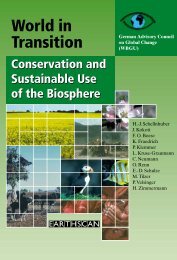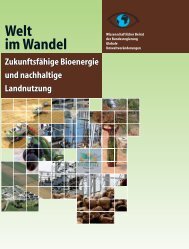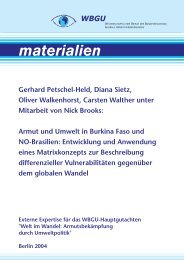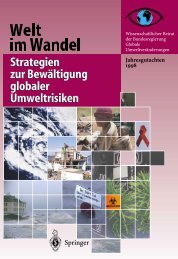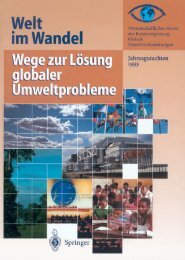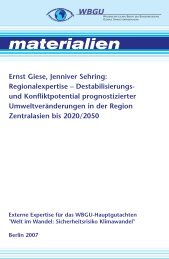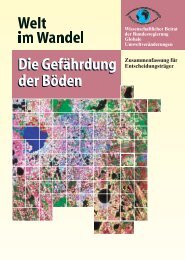World in Transition: Climate Change as a Security Risk - WBGU
World in Transition: Climate Change as a Security Risk - WBGU
World in Transition: Climate Change as a Security Risk - WBGU
Create successful ePaper yourself
Turn your PDF publications into a flip-book with our unique Google optimized e-Paper software.
78<br />
6 Conflict constellations<br />
Box 6.1-1<br />
Scenarios and forec<strong>as</strong>ts<br />
Forec<strong>as</strong>ts are scientifically derived statements on the probable<br />
course of future events with<strong>in</strong> a given time span. The<br />
more complex the field of study and the longer the time<br />
span, the more uncerta<strong>in</strong> forec<strong>as</strong>ts become. In these circumstances,<br />
scenarios are the preferred method; on the one<br />
hand they po<strong>in</strong>t up the range of possible future developments<br />
and focus attention particularly on causal processes,<br />
<strong>in</strong>fluenc<strong>in</strong>g factors and strategic decision po<strong>in</strong>ts. Scenarios,<br />
unlike forec<strong>as</strong>ts, consist of a hypothetical sequence of<br />
events which is constructed <strong>in</strong> order to illustrate causal l<strong>in</strong>kages.<br />
They are not backed up with probabilities. There are<br />
different types of scenario. The typical steps <strong>in</strong> creat<strong>in</strong>g scenarios<br />
are<br />
Instead, they are <strong>in</strong>tended to contribute to identify<strong>in</strong>g,<br />
and hence avoid<strong>in</strong>g, the most risk-laden trends.<br />
The selection of regions for the scenarios is derived<br />
from the analyses <strong>in</strong> Chapter 5. The scenarios beg<strong>in</strong><br />
around the year 2020. Their time horizon extends to<br />
the year 2050, and <strong>in</strong> certa<strong>in</strong> <strong>in</strong>stances <strong>as</strong> far ahead <strong>as</strong><br />
2100. Some of the risks relat<strong>in</strong>g to the second half of<br />
the century have a low probability but high destructive<br />
potential ( tipp<strong>in</strong>g po<strong>in</strong>ts, Section 5.3).<br />
<strong>Climate</strong> change up to mid-century largely<br />
predeterm<strong>in</strong>ed<br />
Until around the middle of the century (2020–2050) it<br />
is hypothesized that climate change will consistently<br />
advance, form<strong>in</strong>g the ‘backdrop’ to possible socioeconomic<br />
developments. Because of the <strong>in</strong>herent<br />
response times of these dynamics, there may already<br />
be dr<strong>as</strong>tic regional climate impacts, e.g. an <strong>in</strong>cre<strong>as</strong>e <strong>in</strong><br />
the frequency or severity of extreme events. The exact<br />
nature of the repercussions on the ground is determ<strong>in</strong>ed<br />
by bifurcations <strong>in</strong> the socio-economic arena,<br />
e.g. whether or not a trend is identified and correspond<strong>in</strong>g<br />
adaptations are made, or whether general<br />
political and social stability improves or deteriorates.<br />
Dur<strong>in</strong>g this period, the scale of climate change itself<br />
can only be <strong>in</strong>fluenced with<strong>in</strong> narrow marg<strong>in</strong>s.<br />
Non-l<strong>in</strong>ear environmental change possible<br />
from mid-century<br />
In develop<strong>in</strong>g scenarios for the middle of the century<br />
onwards, it is <strong>as</strong>sumed that climate change will beg<strong>in</strong><br />
to take on a new quality: <strong>in</strong> this period, its scale will<br />
depend critically on the decisions and actions taken<br />
<strong>in</strong> the first half of the century. In pr<strong>in</strong>ciple, different<br />
trajectories are conceivable for the development of<br />
environmental change. Moreover, under conditions<br />
of <strong>in</strong>tense climate change, possible non-l<strong>in</strong>ear climatic<br />
dynamics such <strong>as</strong> the failure of the Indian monsoon,<br />
– def<strong>in</strong><strong>in</strong>g the parameters (type of scenario, time span,<br />
etc.),<br />
– scenario field analysis, <strong>in</strong>clud<strong>in</strong>g identification of <strong>in</strong>fluences<br />
and analysis of key factors,<br />
– scenario projection, <strong>in</strong>clud<strong>in</strong>g <strong>as</strong>sessment of how key<br />
factors will develop,<br />
– condens<strong>in</strong>g the scenarios <strong>in</strong>to consistent narratives,<br />
– and evaluation of the scenarios.<br />
In the report, narrative scenarios are developed which ‘tell<br />
the stories’ of possible future developments along alternative<br />
trajectories. As far <strong>as</strong> possible, they are b<strong>as</strong>ed on forec<strong>as</strong>ts<br />
about <strong>in</strong>dividual <strong>in</strong>fluenc<strong>in</strong>g factors (e.g. changes <strong>in</strong><br />
the climate). Other <strong>in</strong>fluenc<strong>in</strong>g factors are deduced from<br />
empirical f<strong>in</strong>d<strong>in</strong>gs <strong>in</strong> relation to other processes. The aim<br />
is to envision how developments might potentially unfold<br />
and to identify po<strong>in</strong>ters for strategic political choices at critical<br />
moments.<br />
shifts <strong>in</strong> the Inter-Tropical Convergence Zone or the<br />
weaken<strong>in</strong>g of the North Atlantic Current may lead<br />
to further bifurcation of developmental trajectories.<br />
Effectively this would represent dramatic alteration<br />
of the biogeophysical ‘backdrop’ aga<strong>in</strong>st which socioeconomic<br />
developments are played out. It would<br />
pose major social challenges which could br<strong>in</strong>g forth<br />
either cooperation or conflict. Section 5.3 presents<br />
some examples of non-l<strong>in</strong>ear environmental trends<br />
with a low probability of occurrence but extremely<br />
high destructive potential.<br />
6.1.3<br />
Deriv<strong>in</strong>g recommendations for action<br />
For every conflict constellation and its <strong>as</strong>sociated<br />
scenarios, recommendations are derived for action<br />
which may help to avoid or alleviate the given set of<br />
problems. These <strong>in</strong>clude not only strategies for avoid<strong>in</strong>g<br />
and adapt<strong>in</strong>g to climate change, but also <strong>as</strong>pects<br />
of good governance which make a difference to crisis<br />
prevention. Although some of the repercussions<br />
considered will only occur <strong>in</strong> the distant future, the<br />
aim is to develop recommendations for action for the<br />
present and the near future.





